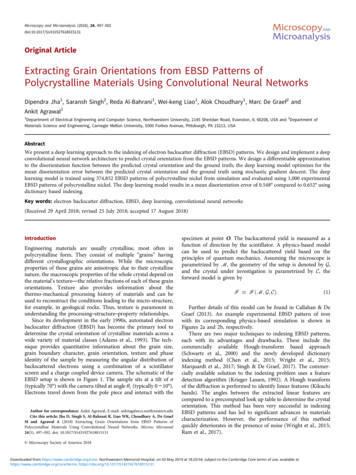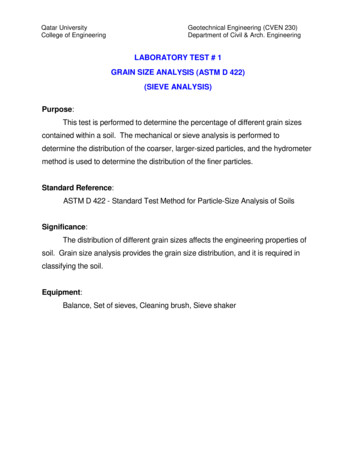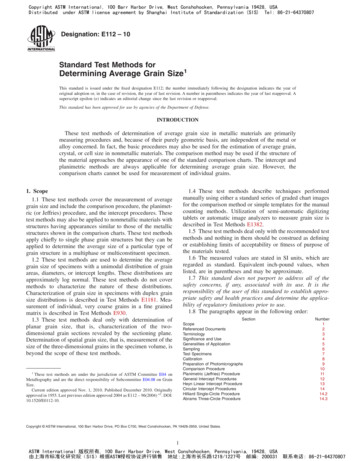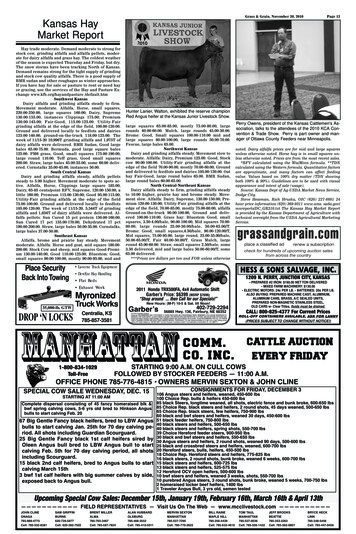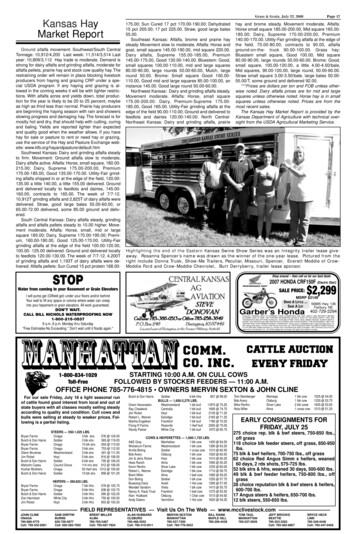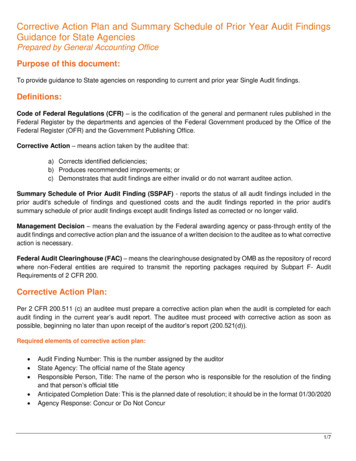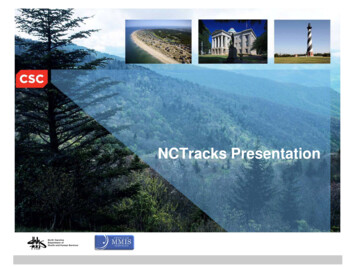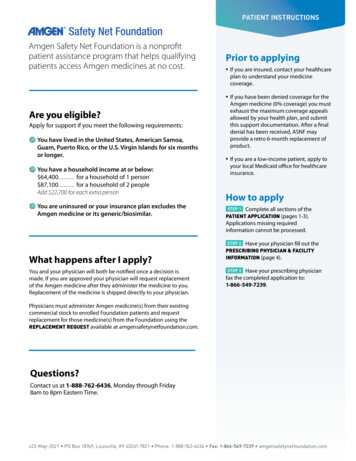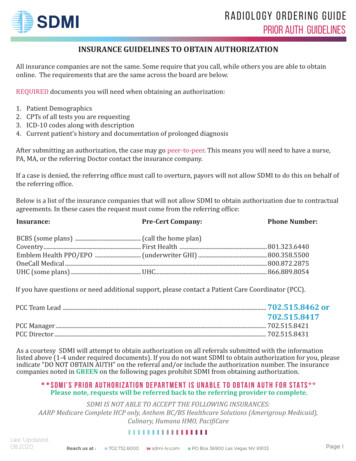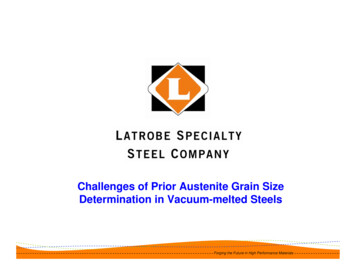
Transcription
Challenges of Prior Austenite Grain SizeDetermination in Vacuum-melted SteelsForging the Future in High Performance Materials
Grain Size still a hot topic after all these years:Path:Date: 29-Nov-11Forging the Future in High Performance Materials2
Path:Date: 29-Nov-11Forging the Future in High Performance Materials3
Marcus Grossman: “ grain size relationships refer to a relationship between theproperties of the piece of metal being tested and the size of thecrystals which compose the piece. In an entirely different categoryare the studies of austenite grain-size in steel, as exemplified bythe widely used McQuaid-Ehn test. Here the steel is examined notfor its actual grain-size while being tested but to discover what itsgrain-size had been previously, namely when it consisted ofcrystals of austenite, at high temperature. “The size of these austenite grains in any individual piece of steelmay be varied in a number of different ways, and so may havelittle or nothing to do with the size of the grains in the piece after ithas cooled and transformed to ferrite.”Path:Date: 29-Nov-11Forging the Future in High Performance Materials4
E.S. Davenport and E.C. Bain: “The grain structure must be well marked out in a specimen atordinary temperature, and therefore no longer austenitic, whichcan be examined under the microscope, for clearly it isimpracticable to examine the specimen at the heatingtemperature just prior to cooling when the austenite is actuallyestablished. This is not entirely easy, for in some cases, thestructure formed during the transformation occasioned by coolingdoes not in any way reflect the grain-boundaries of the parentaustenite.” “In certain slowly-cooled, low carbon steels the ferrite-pearlitepatchwork seen in the microscope bears no apparent relation tothe pattern of the austenitic grains. Nevertheless, in practicallyany steel the austenite grain structure can, with some expenditureof effort, be marked out in an unequivocal manner.”Path:Date: 29-Nov-11Forging the Future in High Performance Materials5
Prior austenite grain boundary delineation Air-melted steels – typically higher in residual elements such asphosphorus and sulfur, which tend to segregate to grainboundaries in austenite. These segregated boundaries can berevealed after austenitic transformation by suitable etchingtechniques. Vacuum-melted steels – typically lower in segregating residualelements than air-melted steels, due to more stringentspecifications. Non-segregated prior austenite grain boundariescan leave very little evidence of their former location intransformed room-temperature microstructures. Directobservation of prior austenite grain boundaries in medium-carbonand low-carbon steels can be difficult.Path:Date: 29-Nov-11Forging the Future in High Performance Materials6
For many steel grades, good prior austenite grain boundarydelineation can be obtained using the carburizing procedureknown as the McQuaid-Ehn test for lower-carbon steels, and theOxidation procedure for medium-carbon steels, as described inthe ASTM E 112 standard. In higher carbon bearing and tool steels, prior austenite grainboundaries can be readily observed in the transformed roomtemperature microstructures, usually by etching in nital.Path:Date: 29-Nov-11Forging the Future in High Performance Materials7
McQuaid-Ehn Test Has been in use for at least 90 years. Commonly used on lowcarbon steels and carburizing steels. Specimens are typically pack-carburized; on cooling, theaustenite grain boundaries are outlined by precipitated proeutectoid carbides. Requires the development of a hypereutectoid carbon level in thecarburized case. Point to consider: Is the austenitic grain structure and graincoarsening behavior in the high-carbon case equivalent to that inthe lower-carbon core? Is this important?Path:Date: 29-Nov-11Forging the Future in High Performance Materials8
McQuaid-Ehn Test – 9310 steel:Path:Date: 29-Nov-11Forging the Future in High Performance Materials9
Oxidation Test Per ASTM E 112, specimens are polished on one face, heated inair at 1575F for one hour, then water quenched to roomtemperature. Surface oxide scale is removed by re-polishing, leaving moreheavily oxidized prior austenite grain boundaries on the repolished surface. Observation: The heavily-oxidized surface can also heavilydecarburized. In most instances, the grain size determination istherefore obtained from a localized region that has a differentcarbon concentration than the underlying material. Does thismatter?Path:Date: 29-Nov-11Forging the Future in High Performance Materials10
Grain size testing experience with two vacuummelted steels: Nitralloy 135M – nitriding steelC.40Mn.60Si.30Cr1.60Mo.35Al1.20 Lesco 53 – carburizing ka – Pyrowear 53, AMS 6308, X-53Path:Date: 29-Nov-11Forging the Future in High Performance Materials11
Nitralloy 135M – Oxidation Test Experience Difficult to produce a grain size that meets the specificationrequirement of ASTM #5 by a comfortable margin. Alloy decarburizes heavily. Prior austenite grain size appears finer in interior regionscompared with decarburized surface region. Polishing technique can affect grain size results. Starting microstructure/heat treat condition can affect grain sizeresults.Path:Date: 29-Nov-11Forging the Future in High Performance Materials12
Polishing techniques ASTM E 112 recommends re-polishing the oxidized face of thepre-polished specimen. Latrobe Steel has, for many years, used an alternative polishingtechnique, which we call “feather” polishing:Path:Date: 29-Nov-11Forging the Future in High Performance Materials13
Effect of oxidizing time - Trials were run using different times at1575F to see if this could affect the oxidized grain size. A strongtrend was not observed.Path:Date: 29-Nov-11 Specimen oxidized for 60minutes at 1575F. Featherpolished, nital etched, 100Xmagnification. Specimen oxidized for 15minutes at 1575F. Featherpolished, nital etched, 100Xmagnification.Forging the Future in High Performance Materials14
Decarburization effect Path:Date: 29-Nov-11Specimen oxidized for 15 minutes at 1575F. Plane of polish isperpendicular to surface. Nital etched.Forging the Future in High Performance Materials15
Effect of polishing technique: Path:Date: 29-Nov-11Pre-polished specimen oxidized for 15 minutes at 1575F.Re-polished flat, nital etched. Plane of polish is withinheavily decarburized near-surface region.Forging the Future in High Performance Materials16
Attempt to reduce decarburization:Path:Date: 29-Nov-11 Specimen coated with aluminabased slurry intended to reducedecarburization and scaling.Oxidized at 1575F for 60minutes. Specimen oxidized at 1575F for60 minutes, without aluminacoating.Forging the Future in High Performance Materials17
Slurry-coated specimen Path:Date: 29-Nov-11Specimen coated with alumina slurry and oxidized for 60 minutes at1575F. Plane of polish is perpendicular to surface. Nital etched.Forging the Future in High Performance Materials18
Effect of starting microstructure/heat treat condition non-annealed versus annealed:Path:Date: 29-Nov-11 Oxidized grain structure of nonannealed Nitralloy 135M billetmaterial. Feather-polished, nitaletched. Same billet material as above,but annealed prior to oxidationheat treatment. Featherpolished, nital etched.Forging the Future in High Performance Materials19
Shepherd fracture grain size – Nitralloy 135M:Path:Date: 29-Nov-11 Specimen hardened from 1575F,tempered at 400F for 2 hours,cooled in liquid nitrogen andfractured. Estimated grain size:ASTM #2 – #6 (duplex).Forging the Future in High Performance Materials20
Grain size testing of Lesco 53: McQuaid-Ehn carburizing test results: Experience to date hasgenerally not been too successful in revealing prior austenitegrain boundaries in carburized case region, regardless of etchingtechnique. Better results have been obtained in revealing grain boundaries inthe non-carburized interior regions. More work is needed to develop a robust, universally acceptablemethod of determining the grain size in this steel. Use of this alloyis increasing, and it will likely replace carburized 9310 in manyaircraft drivetrain applications in the future.Path:Date: 29-Nov-11Forging the Future in High Performance Materials21
McQuaid-Ehn test results: Grain boundaries are rarely visible in the carburized case region. Hypothesis was that cooling conditions may affect theprecipitation of pro-eutectoid carbides at austenite grainboundaries. To investigate this, a series of thermal treatmentswas planned. It was then discovered that the case carbon content of packcarburized specimens was surprisingly low. OES analysisindicated that carbon levels in the case were in the range of0.20% to 0.35%. The lack of pro-eutectoid grain boundary carbide precipitation istherefore no longer a mystery.Path:Date: 29-Nov-11Forging the Future in High Performance Materials22
Lesco 53: Due to the lack of success in revealing grain boundaries in thecase region, the focus has shifted to delineating grain boundariesin the non-carburized core region. Need to decorate austenite grain boundaries with an austenitedecomposition product that can be revealed by etching. Thermal treatment development. Etching technique development. Several labs have been involved with this effort, with varyingamounts of success.Path:Date: 29-Nov-11Forging the Future in High Performance Materials23
Current Latrobe Steel procedure: Pack-carburize in charcoal at 1700F for 4 hours, transfer tofurnace at 1300F, hold for 1 hour at temperature, air cool to roomtemperature. Rough grind, polish through 3 micron diamond. Etch with alcohol solution of 9% HCL, 3% HNO3, a few drops ofH2O2. Submerge for 10 minutes until very dark. Lightly re-polish by hand with 3 micron diamond to partiallyremove etch. Etch with 4% nital.Path:Date: 29-Nov-11Forging the Future in High Performance Materials24
Latrobe Steel results: Path:Date: 29-Nov-11Carburized case regions showlittle or no evidence of grainboundary delineation.Forging the Future in High Performance Materials25
Latrobe Steel results: Path:Date: 29-Nov-11Non-carburized core regionsshow better grain boundarydelineation. These imagesrepresent our best efforts todate.Forging the Future in High Performance Materials26
Latrobe Steel results: Path:Date: 29-Nov-11We also get images like these.Forging the Future in High Performance Materials27
Latrobe Steel results: Path:Date: 29-Nov-11Or even like these, unfortunately.Forging the Future in High Performance Materials28
Results from Laboratory “X” Round robin test results specimens were prepared byanother lab, as follows: Condition – “as-received,”not carburized. Swabbed in Vilella’s reagentfor 5 seconds, followed by 3second swab in Stainless #2etch. Vilella’s: I g picric acid, ml HCl,100 ml methanol.Stainless #2: 50 g FeCl, 50 mlHCl, 100 ml methanol. Path:Date: 29-Nov-11Forging the Future in High Performance Materials29
Results from Laboratories “Y” and “Z”:Thermal treatment and etchingprocedures were not provided.Path:Date: 29-Nov-11 Lab “Y” Lab “Z”Forging the Future in High Performance Materials30
Recent Latrobe result: Path:Date: 29-Nov-11Goal is to outline prior austenite grain boundaries with ferrite. Heat treatment trialsinvolved holding at 1675F for one hour, cooling to 1300F and holding at 1300F forvarious times to obtain ferrite transformation, followed by air cooling to roomtemperature.Specimen below was held at 1300F for 1 hour. A second phase, likely ferrite, isvisible at grain boundaries. Shorter holding times at 1300F did not produce thegrain boundary phase.Forging the Future in High Performance Materials31
George Vander Voort’s work on Lesco 53: Latrobe Steel submitted pack-carburized specimens to George forgrain size determination. Promising results obtained by electrolytic etching.Path:Date: 29-Nov-11Forging the Future in High Performance Materials32
George Vander Voort’s results on Lesco 53:Path:Date: 29-Nov-11 Etchant: 10% Ammoniumpersulfate. 6 V dc, 10 seconds. Interior Case/interiorForging the Future in High Performance Materials33
George Vander Voort’s results on Lesco 53: Path:Date: 29-Nov-11Etchant: 10% Ammoniumpersulfate. 6 V dc, 10 seconds.Forging the Future in High Performance Materials34
George Vander Voort’s results on Lesco 53:Path:Date: 29-Nov-11 Etchant: Lucas’ reagent. 50 ml Lactic acid 150 ml HCl 3 g Oxalic acid 1.6 V dc, 8 seconds.Forging the Future in High Performance Materials35
George Vander Voort’s work on Lesco 53:Path:Date: 29-Nov-11 Etchant: Lucas’ reagent. 50 ml Lactic acid 150 ml HCl 3 g Oxalic acid 1.6 V dc, 8 seconds.Forging the Future in High Performance Materials36
Shepherd fracture grain size – Lesco 53:Path:Date: 29-Nov-11 Specimen hardened from 1675F,tempered at 500F for 2 hours,cooled in liquid nitrogen andfractured. Estimated grain size:ASTM #5.5 – #6.Forging the Future in High Performance Materials37
Some things to consider: Dirty steel can be the metallographer’s friend when it comesto revealing prior austenite grain boundaries. Room temperature, transformed microstructures can bearlittle resemblance to the parent austenite grain structures. Heavily decarburized, oxidized surface regions may showevidence of coarser prior austenite grain size than theinterior regions.Path:Date: 29-Nov-11Forging the Future in High Performance Materials38
More things to consider: Success with McQuaid-Ehn testing requires sufficient carboncontent in the carburized case. Different steel grades react differently to the various grainsize test methods. Customized approaches based on steelgrade are necessary. Shepherd fracture grain size test may not be all that bad!Path:Date: 29-Nov-11Forging the Future in High Pe
Oxidation procedure for medium-carbon steels, as described in the ASTM E 112 standard. . remove etch. Etch with 4% nital. Path: Forging the Future in High Performance Materials Date: 29-Nov-11 25 Latrobe Steel results: Carburized case regions show little or no evidence of grain boundary delineation. Path: Forging the Future in High Performance Materials Date: 29-Nov-11 26 Latrobe Steel .
